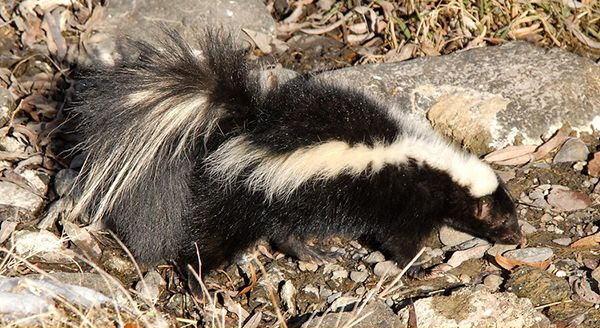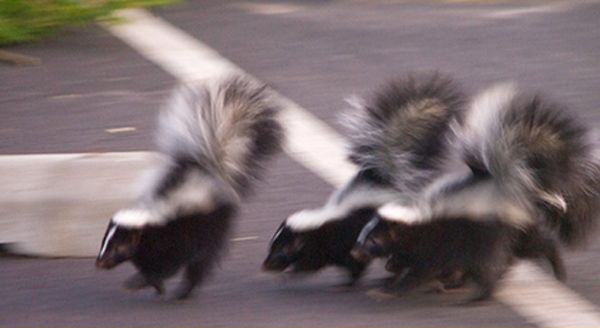
Skunks are infamous for the potent smell from their scent glands, but did you know they also mate frequently? Skunks breed up to two times per year! This may seem like a lot, but skunks must breed so often. The high reproduction rate ensures the species can survive even if some skunks don’t reach adulthood.
With this in mind, do you know other information about their reproduction? Read on to learn the mating habits and mating season of the adults of these species!

Skunks’ mating habit
Do you know how skunks behave before, during, and after mating? Prior to mating, the male skunk will follow the female and spray her with his scent. If she is receptive to his advances, she will not spray him back.
During mating, the female skunk will arch her back to make it easier for the male to mount her. The two will then mate for a period of about 30 minutes. After mating, the male skunk will leave the area while the female skunk will remain to build a nest and raise her young.

Skunks’ mating season
The skunk mating season falls from February through March. This time of the year also connotes the “skunk smell” season. The pungent smell is caused by the male’s spray, which he uses to mark his territory and attract mates.
If you live in an area with a high skunk population, be prepared for the intense smell during this time of year!

Skunks’ gestation period
The pregnancy for skunks is about 63 days, but it can happen anywhere around 60-75 days. This will depend on the adorable skunks’ species, climate, and natural reproduction processes. For example, a striped skunk can gestate as short as 59 days.
During this time, the female skunk will build a nest to raise her young. She will birth four to seven pups, known as “kits.”
Skunks’ breeding season
The skunk breeding season does not automatically call female skunks to mate. Some of them need time!
Aside from the smell that attracts mates, there’s also a specific aroma that female skunks release when they’re not in the mood. They do this to shoo male skunks that try to court them.
Skunks are also famous for digging dens and nests. They sometimes roam around neighborhoods, which makes them choose decks and porches to create their skunk den. So, if you see them on your property around February to May, do not harm them and just let them be.

Skunk breeding habits
Did you know that male skunks can travel as far as 5 miles (10 kilometers) in search of a mate? And that’s not all – skunks can also mate with multiple partners! A female skunk may mate with several males in one breeding season.
So how often do skunks breed? Skunks can breed up to two times yearly, with the peak mating season occurring from February to March. This high reproduction rate is necessary for the species’ survival, as not all skunks will reach adulthood.
Skunks’ kittens were born in March and April
Kittens are born approximately 63 days after mating, usually in March and April. Younger females, though, tend to give birth in spring. These skunks can have a litter of anywhere from one to seven skunk babies, though the average litter size is four.
A mother skunk will raise their babies in dens. They will become aggressive during this period, although they’re generally non-aggressive animals. They will defend and attack the invader if they feel like their babies are in danger.

Skunks’ baby called kittens
A skunk’s offspring is called a “Kit.” The kits are born blind and deaf and will remain in the nest for the first few weeks of their lives. The female skunk will care for her young until they are old enough to fend for themselves, typically around six weeks.
Their condition is referred to as altricial. Contrary to precocial animals, born fully developed and able to fend for themselves soon after birth.
These kits weigh about 35 grams. Although naked and uncoated, these young skunks already show stripe patterns on their skin pigmentation. Their eyes will open at3 weeks, and they’re already capable of releasing their musk as soon as the 8th day.
After they leave the nest, the young skunks will stay with their mothers until they are ready to mate. This typically occurs during their second year of life.

Behavioral Dynamics of Skunks
When skunks feel threatened, they will first try to escape. If that’s not possible, they will turn around and raise their tail to show the warning sign of their musk sacs. When the intruder doesn’t get the message, that’s when they spray.
The skunk’s anal glands are located just inside the anus. The musk is sprayed toward the intruder when the skunk squeezes these glands. The spray can travel up to 15 feet (5 meters) and irritate the eyes, nose, and mouth.
The smell of skunk musk can be powerful and last for weeks. This is why it’s essential to avoid getting sprayed by a skunk!

Have A Skunks Infestation Problem? Call Us Today!
Like foxes, raccoons, or any other wild animal, skunks are not fun to have around. Skunks can cause damage to your property, and their smell can be challenging to get rid of. As homeowners, nothing’s more annoying than this.
If you think you may have a skunk infestation, it’s important to act fast. At AAAC Wildlife Removal, we specialize in skunk removal and control. We will work quickly and efficiently to remove the skunks from your property and prevent them from returning.
Call us today to learn more about our skunk removal services!
Summary
Skunks mate once or twice a year, with the peak season occurring from February to March. A female skunk can have a litter of anywhere from one to twelve baby skunks, though the average number of litters produced is four. Skunks’ offspring are called “kits,” born blind, deaf, and unable to fend for themselves.
Now that you know more about skunk breeding habits, you can be on the lookout for these exciting creatures! Be sure to keep your distance, though – the last thing you want is to get sprayed by a skunk!
FAQs
What do skunks eat?
Skunks belong to the family of omnivores. Most skunks love to eat a variety of small rodents like rats and mice and insects like grasshoppers, crickets, beetles, and grubs. They will also eat bird eggs since they’re able to climb trees. During the winter, their diet may change. They may eat more fruits, grass, pet food, bird seeds, nuts, and other plants.
What part of my house can skunks hide in?
Skunks can infest your home, make their den site, and spend a few days hiding under your sheds, porch, or crawlspace. They can even get inside your home with open vents and holes. You may also see them chasing and running around your lawn.







